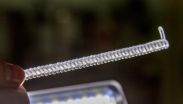(Press-News.org) Lemurs, the most endangered mammal group on Earth, represent more than 20 per cent of the world's primates. Native only to Madagascar, more than 90 percent of the species are threatened with extinction.
A Western University primatologist has teamed with 18 lemur conservationists and researchers, many of whom are from Madagascar or have been working there for decades, to devise an action plan to save Madagascar's 101 lemur species. The action plan contains strategies for 30 different priority sites for lemur conservation and aims to help raise funds for individual projects.
Ian Colquhoun from Western's Faculty of Social Science co-authored a 'Policy Forum' commentary titled "Averting Lemur Extinctions amid Madagascar's Political Crisis" for the high-impact journal, Science, with many of the top primatologists in the world, including Christoph Schwitzer, head of research at Bristol Zoo Gardens and vice-chair for Madagascar of the International Union for Conservation of Nature (IUCN) SSC Primate Specialist Group, and Russell Mittermeier, President of Conservation International and Chair of the IUCN SSC Primate Specialist Group.
Vital steps outlined by the collaborators include effective management of Madagascar's protected areas, the creation of more reserves directly managed by local communities, and a long-term research presence in critical lemur sites.
"Through seed dispersal and attracting income through ecotourism, lemurs have important ecological and economic roles for Madagascar," says Colquhoun, a professor in Western's Department of Anthropology and Chair of the Master's in Environment and Sustainability Program in Western's Centre for Environment & Sustainability. "I think there is huge potential for Malagasy all over the island to take pride in their lemurs."
Native to the shrinking and fragmented tropical and subtropical forests of Madagascar, off Africa's Indian Ocean coast, lemurs are facing grave extinction risks driven by human disturbance of their habitats. Combined with increasing rates of poaching and the loss of funding for environmental programs by most international donors in the wake of the political crisis in Madagascar, challenges to lemur conservation are immense.
INFORMATION:
ABOUT WESTERN
Western delivers an academic experience second to none. Since 1878, The Western Experience has combined academic excellence with life-long opportunities for intellectual, social and cultural growth in order to better serve our communities. Our research excellence expands knowledge and drives discovery with real-world application. Western attracts individuals with a broad worldview, seeking to study, influence and lead in the international community.
Follow Western Media Relations online:
Website: http://communications.uwo.ca/media/
RSS: http://feeds.feedburner.com/MediaWesternU
Twitter: https://twitter.com/mediawesternu
Western University primatologist teams with international group to save lemurs
2014-02-20
ELSE PRESS RELEASES FROM THIS DATE:
Vibration energy the secret to self-powered electronics
2014-02-20
MADISON — A multi-university team of engineers has developed what could be a promising solution for charging smartphone batteries on the go — without the need for an electrical cord.
Incorporated directly into a cell phone housing, the team's nanogenerator could harvest and convert vibration energy from a surface, such as the passenger seat of a moving vehicle, into power for the phone. "We believe this development could be a new solution for creating self-charged personal electronics," says Xudong Wang, an assistant professor of materials science and engineering at the ...
Study in mice raises question: Could PTSD involve immune response to stress?
2014-02-20
COLUMBUS, Ohio – Chronic stress that produces inflammation and anxiety in mice appears to prime their immune systems for a prolonged fight, causing the animals to have an excessive reaction to a single acute stressor weeks later, new research suggests.
After the mice recovered from the effects of chronic stress, a single stressful event 24 days later quickly returned them to a chronically stressed state in biological and behavioral terms. Mice that had not experienced the chronic stress were unaffected by the single acute stressor.
The study further showed that immune ...
Nanoscale pillars could radically improve conversion of heat to electricity
2014-02-20
University of Colorado Boulder scientists have found a creative way to radically improve thermoelectric materials, a finding that could one day lead to the development of improved solar panels, more energy-efficient cooling equipment, and even the creation of new devices that could turn the vast amounts of heat wasted at power plants into more electricity.
The technique—building an array of tiny pillars on top of a sheet of thermoelectric material—represents an entirely new way of attacking a century-old problem, said Mahmoud Hussein, an assistant professor of aerospace ...
Developing countries face 'leading medical scourge of developed countries'
2014-02-20
(Garrison, NY) Chronic illness, already a major and expensive problem in developed countries, is rapidly increasing in developing countries, adding to the longstanding burden caused by high rates of infectious diseases. However, poor countries will not be able to afford the costly medical technologies that wealthy countries use to treat chronic conditions, including heart disease, stroke, cancer, pulmonary disease, and diabetes, writes Daniel Callahan, cofounder of The Hastings Center.
Callahan examines this trend and concludes that it calls for a new, more economically ...
Long-term daily multivitamin supplement use decreases cataract risk in men
2014-02-20
SAN FRANCISCO – Feb. 20, 2014 – Long-term daily multivitamin supplement use may lower cataract risk in men, according to a study of nearly 15,000 male physicians published this month in Ophthalmology, the journal of the American Academy of Ophthalmology.
Past observational studies have indicated a relationship between nutritional supplement use and eye health. However, randomized trial data on the effects of long-term multivitamin supplement use and risk of eye diseases are limited and, in some cases, non-existent. To address this, researchers based at Brigham and Women's ...
Extreme weather decides distribution of insects
2014-02-20
As climate change is progressing, the temperature of our planet increases. This is particularly important for the large group of animals that are cold-blooded (ectothermic), including insects. Their body temperature is ultimately determined by the ambient temperature, and the same therefore applies to the speed and efficiency of their vital biological processes.
But is it changes in average temperature or frequency of extreme temperature conditions that have the greatest impact on species distribution? This was the questions that a group of Danish and Australian researchers ...
UT Dallas-led team makes powerful muscles from fishing line and sewing thread
2014-02-20
An international team led by The University of Texas at Dallas has discovered that ordinary fishing line and sewing thread can be cheaply converted to powerful artificial muscles.
The new muscles can lift a hundred times more weight and generate a hundred times higher mechanical power than the same length and weight of human muscle. Per weight, they can generate 7.1 horsepower per kilogram, about the same mechanical power as a jet engine.
In a paper published Feb. 21 in the journal Science, researchers explain that the powerful muscles are produced by twisting and ...
Bioengineered growth factors lead to better wound healing
2014-02-20
When we are wounded, our bodies naturally begin a process of repair of the damaged tissue. This process is mediated by biological molecules called growth factors, which are proteins that occur naturally in our cells and guide processes ranging from embryonic development to healing. Given their regenerative role in the body, growth factors have been investigated for use in drugs but with limited success. Publishing in Science, an EPFL group has used bioengineering to significantly improve the efficacy of clinical growth factors in the context of soft tissue and bone repair, ...
Previous rapid thinning of Pine Island Glacier sheds light on future Antarctic ice loss
2014-02-20
New research, published this week in Science, suggests that the largest single contributor to global sea level rise, a glacier of the West Antarctic Ice Sheet, may continue thinning for decades to come. Geologists from the UK, USA and Germany found that Pine Island Glacier (PIG), which is rapidly accelerating, thinning and retreating, has thinned rapidly before. The team say their findings demonstrate the potential for current ice loss to continue for several decades yet.
Their findings reveal that 8000 years ago the glacier thinned as fast as it has in recent decades, ...
Scientists create powerful artificial muscle with fishing line
2014-02-20
Researchers are using fibres from fishing line and sewing thread to create inexpensive artificial muscles that could be used in medical devices, humanoid robots, prosthetic limbs, or woven into fabrics.
In a study published today in Science, international researchers, including University of British Columbia Electrical and Computer Engineering professor John Madden and PhD candidate Seyed Mohammad Mirvakili, detail how they created inexpensive artificial muscles that generate far more force and power than human or animal muscles of the same size.
"In terms of the strength ...



